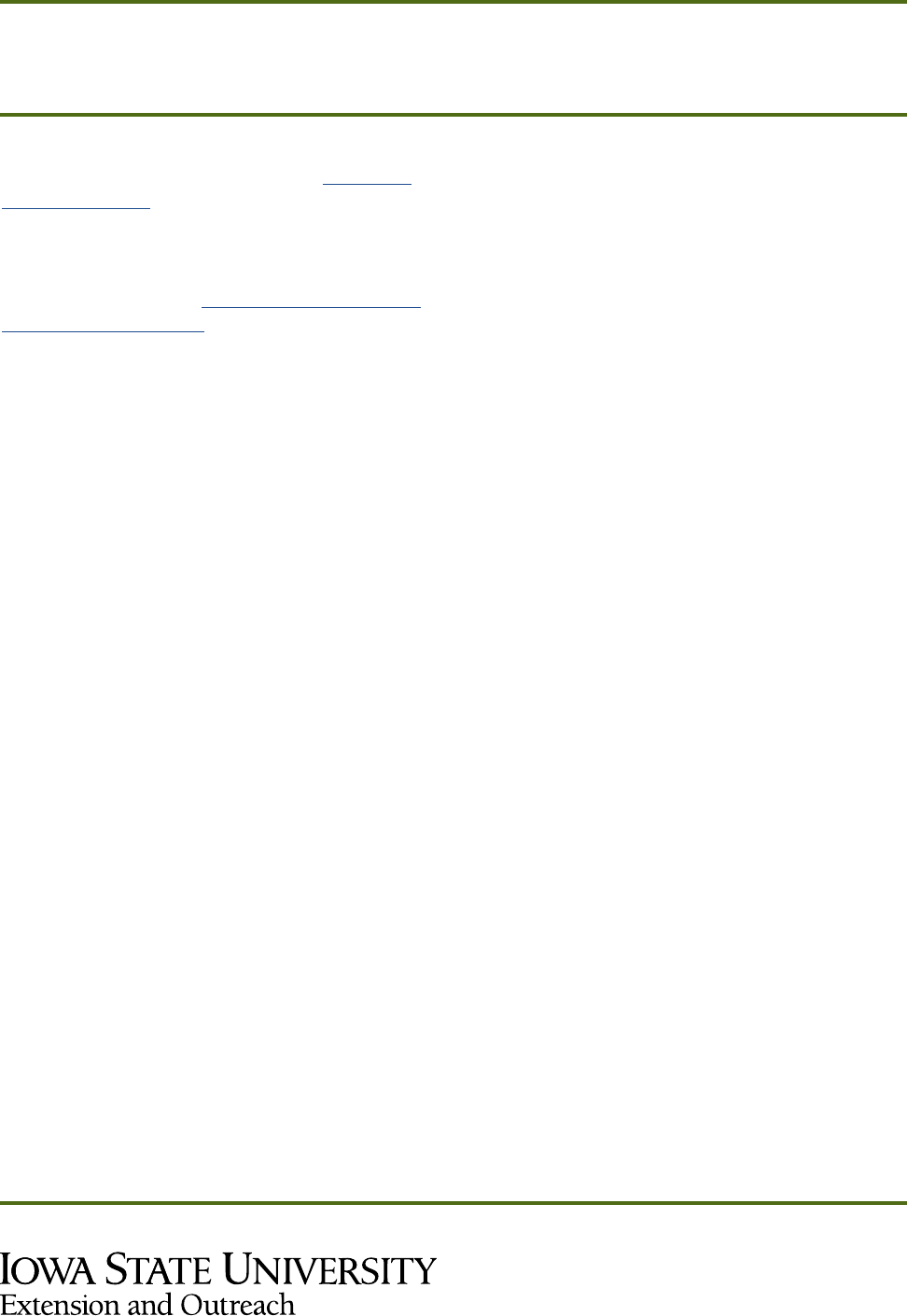
Reviewed July 2020
Feasibility Study Outline
Ag Decision Maker
www.extension.iastate.edu/agdm
File C5-66
A feasibility study is an important step in business
development. Information File C5-65, What is a
Feasibility Study, www.extension.iastate.edu/
agdm/wholefarm/pdf/c5-65.pdf, will help you
understanding the concept of a feasibility analysis
and what it means for business development.
Information File C5-64, When to Do and How to
Use a Feasibility Study, www.extension.iastate.
edu/agdm/wholefarm/pdf/c5-64.pdf, provides
you with a framework and the decision points
needed for using a feasibility analysis in business
development.
The outline below can be used to help you
through the feasibility study process. However,
not all feasibility studies are alike. The elements to
include in a feasibility study vary according to the
type of business venture analyzed and the kind of
market opportunities identified.
Below is a listing of typical factors to include.
However, this may not be a complete listing of
the factors that should be considered in your
specific situation. A “well-done” feasibility
study is based on the careful identification and
assessment of all of the issues important to your
specific business idea. Depending on the business
project, additional items may also be important.
Remember, the basic premise of a feasibility
study is to determine the potential for success, or
viability, of a proposed business venture.
Description of the Product or Service
Identification and exploration of business
scenarios
• Identify alternative scenarios or business
models of what the project will entail, how
it will be organized, and how it will generate
profits. These may come from the idea
assessment or market assessment that you may
have already completed.
• Eliminate scenarios that don’t make sense.
• Flesh-out the scenario(s) that appear to have
potential for further exploration.
Define the project and alternative scenarios
• Describe the type and quality of product(s)
or service(s) to be marketed.
• Outline the general business model (i.e. how
the business will make money).
• Include the technical processes including size,
location, kind of inputs, etc.
• Specify the time horizon from the time the
project is initiated until it is up and running at
capacity.
Relationship to the surrounding geographic area
• Outline the economic and social impact on
local communities.
• Describe the environmental impact on the
surrounding area.
Market Feasibility (Strategy)
This can be based on a market assessment that you
may have already completed.
Industry or marketplace description
• Describe the size and scope of the industry,
market or market segment(s).
• Estimate the future direction of the industry,
market or market segment(s).
• Describe the nature of the industry, market
or market segment(s). Is it stable or going
through rapid change and restructuring?
• Identify the life-cycle of the industry, market
or market segment(s). Is it emerging, growing,
mature, declining?
Industry competitiveness
• Describe the industry concentration. Are
there just a few large producers or many small
producers?
• Describe the major competitors? Will you
compete directly against them?

Page 2
Feasibility Study Outline
• Analyze the barriers to entry of new
competitors into the market or industry. Can
new competitors enter easily?
• Analyze the concentration and competitiveness
of input suppliers and product or service
buyers.
• Describe the price competitiveness of your
product or service.
Specific market potential
• Identify whether the product will be sold
into a commodity market or a differentiated
product or service market.
• Identify the demand and usage trends of
the market or market segment in which the
product or service will participate.
• Examine the potential for emerging, niche or
segmented market opportunities.
• Explore the opportunity and potential for a
branded product.
• Assess market usage and your potential share
of the market or market segment.
Access to market outlets
• Identify the potential buyers of the product or
service and the associated marketing costs.
• Investigate the product or service distribution
system and the costs involved.
Sales projection
• Estimate sales or usage.
• Carefully identify and assess the accuracy
of the underlying assumptions in the sales
projection.
• Project sales under various assumptions
(i.e. selling prices, services provided, etc.).
Technical Considerations
Facility needs
• Estimate the size and type of production
facilities.
• Investigate the need for related buildings,
equipment, rolling-stock, etc.
Suitability of production technology
• Investigate and compare technology providers.
• Determine reliability and competitiveness of
technology (proven or unproven, state-of-the-
art, etc.)
• Identify limitations or constraints of the
technology.
Availability and suitability of site
• Investigate access to:
- raw materials
- transportation
- labor
- production inputs (electricity, natural gas,
water, etc.)
• Investigate potential emissions problems.
• Analyze other environmental impacts.
• Identify regulatory requirements.
• Explore economic development incentives.
Raw materials
• Estimate the amount of raw materials needed.
• Investigate the current and future availability
and access to raw materials.
• Assess the quality and cost of raw materials.
Other inputs
• Investigate the availability of labor including
wage rates, skill level, etc.
• Assess the potential to access and attract
qualified management personnel.
Financial Projections or Economic
Feasibility
Estimate the total capital requirements
• Assess the “seed capital” needs of the business
project during the investigation process and
start-up, and how these needs will be met.
• Estimate capital requirements for facilities,
equipment and inventories.
• Estimate working capital needs.
• Estimate start-up capital needs until revenues
are realized at full capacity.

Page 3
Feasibility Study Outline
• Estimate contingency capital needs due to
construction delays, technology malfunction,
market access delays, etc.
• Estimate other capital needs.
Estimate equity and credit needs
• Estimate equity needs.
• Identify alternative equity sources and capital
availability – family, producers, local investors,
angel investors, venture capitalists, etc.
• Estimate credit needs.
• Identify and assess alternative credit sources
- banks, government (i.e. direct loans or
loan guarantees), grants and local and state
economic development incentives.
Budget expected costs and returns of various
alternatives
• Estimate the expected revenue, costs, profit
margin and expected net profit.
• Estimate the sales or usage needed to break
even.
• Estimate the returns under various production,
price and sales levels. This may involve
identifying “best case”, “typical”, and “worst
case” scenarios or more sophisticated analysis
like a Monte Carlo simulation.
• Assess the reliability of the underlying
assumptions of the analysis (prices,
production, efficiencies, market access,
market penetration, etc.)
• Benchmark against industry averages and/or
competitors (cost, margin, profits, ROI, etc.)
• Identify limitations or constraints of the
economic analysis.
• Calculate expected cash flows during the
start-up period and when the business reaches
capacity.
• Prepare pro forma income statement, balance
sheet, and other statements of when the
business is fully operating.
Organization Structure and Managerial
Feasibility
Business structure
• Identify the proposed legal structure of the
business.
• Outline the staffing and governance structure
of the business along with lines of authority
and decision making structure.
• Identify any potential joint venture partners,
alliances or other important stakeholders.
• Identify the availability of skilled and
experienced business managers.
• Identify the availability of consultants and
service providers with the skills needed to
realize the project, including legal, accounting,
industry experts, etc.
Business founders
• Character matters - are the people involved of
outstanding character?
• Do the founders have the “fire in the belly”
required to take the project to completion?
• Do the founders have the skills and ability to
complete the project?
• What key individuals will lead the project?
• Is there a reward system for the founders? Is it
based on business performance?
• Have the founders organized other successful
businesses?
Study Conclusions
After the feasibility study has been completed and
presented to the leaders of the project, they should
carefully study and analyze the conclusions and
underlying assumptions. It is important that the
study conclusion:
• Identifies and describes alternative business
scenarios and models.
• Compares and contrasts scenarios based on
goals of the producer group.
• Outlines criteria for decision making among
alternatives.

Page 4
Feasibility Study Outline
Reviewed by Gary Wright, extension farm management field specialist, [email protected]
Originally written by Don Hofstrand, retired extension value added agriculture specialist and
Mary Holz-Clause, former co-director, Ag Marketing Resource Center, former associate vice president
for ISU Extension and Outreach
www.extension.iastate.edu/agdm
This institution is an equal opportunity provider. For the full non-discrimination statement or
accommodation inquiries, go to www.extension.iastate.edu/diversity/ext.
Next Steps
This final outline step is sometimes referred to as
the “go/no go” decision. The leaders will be faced
with deciding the specific course(s) of action
to pursue. This schedule of potential courses of
action may include:
• Choosing the most viable business scenario or
model; and then (a) developing that scenario’s
business plan; (b) proceeding with creating;
and (c) operating the project or business.
• Identifying additional scenarios for further
study.
• Deciding that a viable business opportunity is
not available and moving to end the business
investigation process.
• Following another course of action.
For more information on feasibility and business
plans, visit the Ag Decision Maker website, www.
extension.iastate.edu/agdm/vdstart.html.
Note: this publication is for informational purposes
only, the authors do not conduct or assist with
feasibility studies.
